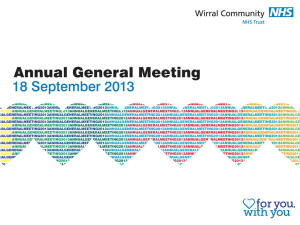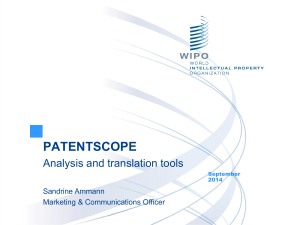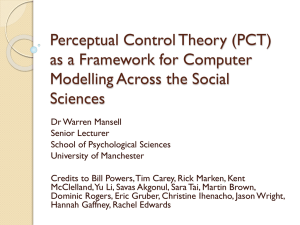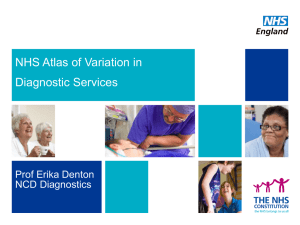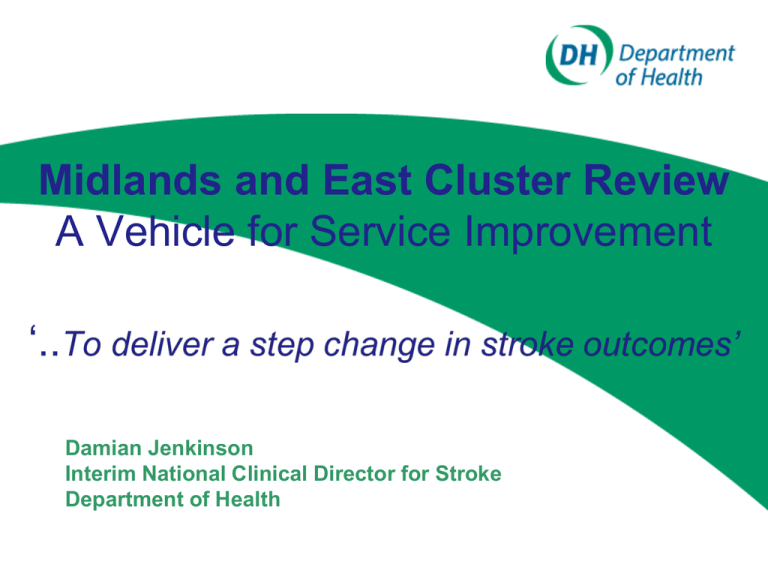
Midlands and East Cluster Review
A Vehicle for Service Improvement
Damian Jenkinson
Interim National Clinical Director for Stroke
Department of Health
Addressing Quality and Productivity
Midlands and East Review of Stroke
Services
•
Clear process
•
Service specification to high aspirations for
whole stroke pathway
•
No prescription of model or configuration to
deliver stroke services
•
External Expert Advisory Group
C) Includes:
i. Hyper-acute services
ii. Acute services (including
in-hospital rehabilitation)
iii. TIA services
iv. Tertiary care services e.g.
Vascular and neuro-surgery
D) Includes:
i. Early Supported
Discharge (ESD)
ii. Stroke specialist
community
rehabilitation
Summary Hospital Level Mortality
Indicator for Stroke 2010/11
SHMI
2010/11
Yorkshire and the Humber Strategic Health Authority
West Midlands Strategic Health Authority
East Midlands Strategic Health Authority
North West Strategic Health Authority
North East Strategic Health Authority
South East Coast Strategic Health Authority
East of England Strategic Health Authority
South Central Strategic Health Authority
South West Strategic Health Authority
London Strategic Health Authority
112.1
109.8
104.8
105.2
104.5
104.4
103.1
98.4
95.6
75.9
Source: HES – SHMI downloaded October 2011
4
Regional Cluster Stroke Performance
National Vital Signs
Stroke - %
spending
90% on
Stroke Unit
Q1
11/1
2
Q2
11/1
2
Q3
11/1
2
Q4
11/1
2
Stroke –
Higher risk
TIAs
treated
within 24
hours
Q1
11/12
Q2
11/1
2
Q3
11/1
2
Q4
11/1
2
ENGLAND
77.8
%
81.6
%
82.8
%
81.7
%
ENGLAND
68.8%
70.1
%
70.5
%
71.2
%
Midlands &
East
74.8
%
81.1
%
81.5
%
80.4
%
Midlands
& East
65.0%
63.4
%
65.7
%
66.2
%
East
Midlands
71.5
%
77.2
%
80.7
%
78.0
%
NHS East
Midlands
73.2%
62.0
%
66.4
%
71.9
%
West
Midlands
76.0
%
82.7
%
84.5
%
81.1
%
NHS West
Midlands
64.4%
66.7
%
72.5
%
65.4
%
East of
England
76.4
%
82.8
%
79.3
%
81.2
%
NHS East of 54.5%
England
61.2
%
54.7
%
60.8
%
Targets: 80% of patients spending over 90% of they stay on a stroke unit
60% of high risk TIA patients scanned and treated in under 24 hours
Nottingham City PCT
0%
Solihull PCT
B'ham and Solihull
Heart of Birmingham
Birmingham East and
Cambridgeshire PCT
Cambridgeshire &
Leicestershire County and
Hertfordshire PCT
Leicestershire
Leicester City PCT
South Birmingham PCT
Norfolk PCT
Bedfordshire PCT
Norfolk & Waveney
Worcestershire PCT
Peterborough PCT
Herefordshire PCT
South East Essex PCT
Lincolnshire Teaching PCT
South Staffordshire PCT
Derby City PCT
South Essex
NHS Midlands & East
Bedfordshire & Luton
Derbyshire
Derbyshire County PCT
West Mercia
South West Essex PCT
Staffordshire
Mid Essex PCT
Great Yarmouth and
Warwickshire PCT
North Staffordshire PCT
Suffolk PCT
Sandwell PCT
North Essex
100%
North East Essex PCT
Northamptonshire
Arden
Walsall Teaching PCT
Northamptonshire&Milton
Black Country
Luton PCT
Wolverhampton City PCT
Dudley PCT
West Essex PCT
Coventry Teaching PCT
Stoke on Trent PCT
Shropshire County PCT
Nottinghamshire County
Nottinghamshire
Milton Keynes
Target 60%
TIA % treated within 24 hours: Q4 2011- 12
80%
60%
40%
20%
Lincolnshire Teaching PCT
Solihull PCT
South Birmingham PCT
Great Yarmouth and
Derby City PCT
Worcestershire PCT
Cambridgeshire PCT
Wolverhampton City PCT
Mid Essex PCT
Luton PCT
Bedfordshire & Luton
Bedfordshire PCT
Norfolk & Waveney
Leicester City PCT
Cambridgeshire &
Derbyshire
Leicestershire
Milton Keynes
B'ham and Solihull
Norfolk PCT
Leicestershire County and
Warwickshire PCT
Arden
Coventry Teaching PCT
Black Country
NHS Midlands & East
Sandwell PCT
Derbyshire County PCT
West Essex PCT
Peterborough PCT
Walsall Teaching PCT
Dudley PCT
North Essex
West Mercia
Suffolk PCT
North Staffordshire PCT
South Staffordshire PCT
Staffordshire
Herefordshire PCT
Hertfordshire PCT
Northamptonshire&Milton
Stoke on Trent PCT
Shropshire County PCT
Northamptonshire
Birmingham East and
Nottinghamshire County
South East Essex PCT
South Essex
South West Essex PCT
Nottinghamshire
Heart of Birmingham
North East Essex PCT
Nottingham City PCT
Telford and Wrekin PCT
0%
Telford and Wrekin PCT
NHS Midlands and East
Range in Vital Sign Performance
Target 80%
Stroke 90% of stay on stroke unit: Q4 2011-12
100%
80%
60%
40%
20%
SSNAP Organisational
Audit 2012
SSNAP Organisational
Audit 2012
Challenges to The Review
• NHS M&E covers a quarter of the country; an area
the size of Belgium
• Major variation in geographical and demography
• Complete the review before SHA’s abolition March
2013
• Pace at a time of major organisational change:
– abolition of stroke networks, PCTs, SHA
– transition to CCG commissioning
– development of strategic clinical networks, Area Teams
– agreeing ownership beyond NHS ‘transition’
• Expectation of no additional financial pump priming
Service Specification
Midlands and East Review of Stroke
Services
Service Specification
Midlands and East Review of Stroke
Services
Performance Standards
Midlands and East Review of Stroke
Services
<6
months
Performance
Standards
6-12
Months
1. Percentage of all stroke patients
admitted to hyper acute unit within 4
hours of arrival to hospital (SSNAP)
90%
1. Percentage of patients seen and
assessed within 30mins of admission
by a specialist in stroke (SSNAP)
90%
95%
1. Percentage of appropriate patients
having thrombolysis within 60 mins of
entry (door to needle time) (SSNAP)
85%
90%
1. Percentage of appropriate patients
having thrombolysis within 45 mins of
entry (door to needle time) (SSNAP)
1. Percentage of appropriate patients
having thrombolysis within 30 mins of
entry (door to needle time) (SSNAP)
>18
months
95%
90%
50%
Does Size Matter?
SINAP 2012:
4347 receiving
tPA (10.3% of
42,024 patients
with acute
ischaemic
stroke admitted
to 80 hospitals).
Stroke onset-arrival times by thrombolysis volume, as a
proportion of all patients admitted with ischaemic stroke
Does Size Matter?
78 min
72 min
50 min
MEDIAN
Bold Solutions to Large Scale
Problems
London Stroke Service
30-Minute Blue Light Ambulance Travel Time
from the Hyper-Acute Stroke Units
• Population >8million
• 11,500 strokes a year in London – 2,000 deaths
• Commitment to whole system redesign
London Stroke Survival is Higher
Than Rest of England
Hazard ratio for survival in London
0.72 95%CI 0.67-0.77 p<0.001
Cost-Effectiveness of London Stroke
Service
Based on 6438 strokes per annum
Differences in
Unadjusted
Adjusted
3,307,677
3,763,472
Differences in total deaths at 30 days
-214
-68
Differences in total QALYs at 30 days
51
44
Incremental cost per death averted at 30 days
15,451
55,371
Incremental cost per QALY gained at 30 days
64,478
86,106
-5,393,533
-3,544,210
Differences in total deaths at 90 days
-238
-98
Differences in total QALYs at 90 days
112
86
Incremental cost per death averted at 90 days
Dominant
Dominant
Incremental cost per QALY gained at 90 days
Dominant
Dominant
Differences in total costs at 10 years
-21,318,180
-22,786,954
Differences in total QALYs at 90 days
4,492
3,886
Dominant
Dominant
Differences in total costs at 30 days
Differences in total costs at 90 days
Incremental cost per QALY gained at 10 years
Stroke Patient Conveyance Pathway
Pathway sub-process
Call to door time
T0
T1
T2
T3
T4
Stroke
event
Emergency
call
Ambulance
at scene
Ambulance
leaves scene
Arrival at
hospital
T0 - T1
T1 - T 2
T2 - T3
T 3 - T4
• Act F.A.S.T.
campaign
• Ambulance dispatch
locations
• Interventions at
the scene
• Patient location
• Telemedicine
• Location of nearest
RVV/ambulance
• Need to wait for
double-staffed
ambulance
• Traffic density
• HASU configuration
High Level EEAG Appraisal Criteria
A. Clinically sustainable and future proofed
B. Whole stroke patient pathway
C. Equitable access irrespective of socio economic status
D. Coproduced: health and social care; for people outside
area
E. Services accessible by residents and travellers
F. All needed services of equal importance e.g. medical,
nursing, therapy, psychological support etc
G. Plans will improve stroke mortality; patient's quality
of life; and patient’s and carer’s experience of care
H. Services are cost effective and financially sustainable
19
Concluding Proposals
• From 45 acute stroke providers…
• To 30 HASUs, with EEAG recommendations to
reduce to 25 HASUs
• Challenges of rurality and access in 60min travel
time
• Commissioner led proposals
• NCB Area Teams engaged to support performance
management of implementation
• Implementation support :new Strategic Clinical
Networks
Summary of Proposed Locations
Making It Happen
Handover Legacy
Pack
•
•
•
•
Area Teams
Clinical Senates
CCGs
Strategic Clinical
Networks
• NHS IQ
• AHSN
• Health and
Wellbeing Boards
Making It Happen
New Policy
Early Supported
Discharge
Challenge
ESD where appropriate,
Extend provision from 20% to
40%
Improvements
1080 pa fewer deaths
dependencies, cost neutral
Levers
NHS IQ to promote
SSNAP audit
Rehabilitation
Access and Uptake
TIA
Specialist TIA
Assessment
ESD
Acute Stroke
Specialist
Stroke Rehab
Acute Cardiac
Specialist
Cardiac Rehab
Acute PAD
Specialist PAD
Rehab
Community
Stroke Team
Cardiovascular
Rehab
? CVD Educational Framework ?
Access to Psychological
Support
Challenge
Improve provision and
access
Improvements
QoL
Patient experience
Cost saving at 2 years
Levers
QIPP
SSNAP audit
Long Term Care
Integration is Key
Joint
Care
Planning
Preventing
Dependency/
need
Monitor
/manage
needs
Specialist/
Broader
rehab
Identify/
Monitor
need
Patient &
Carer Experience
Empowerment
Self-management
Recovery/
Rehabilitation
CVD risk
assess and
treat
End of Life
Care
Assess/
Monitor
need
Secondary
specialist
care
Other
routes in
eg HC
Midlands and East Cluster Review
A Vehicle for Service Improvement
Damian Jenkinson
Interim National Clinical Director for Stroke
Department of Health

